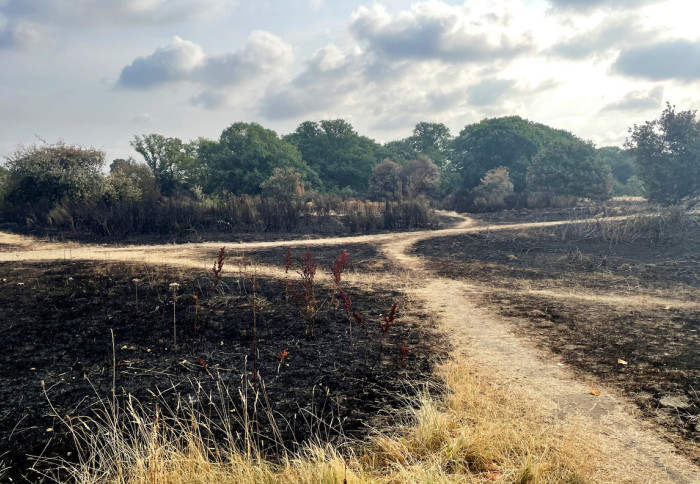
Aftermath of a forest fire in Epping Forest, North London

New study finds human-caused climate change will increase the likelihood and severity of heatwaves in the UK faster than predicted.
On 18 and 19 July 2022, the UK experienced record-breaking heat with temperatures reaching over 40°C. The UK has little experience with extreme heat, and the conditions led to widespread suffering. Care services supporting the elderly and vulnerable were put under increased stress; a surge in emergency calls and hospitalisations put immense strain on health systems, and early estimates suggest that there were nearly 1,000 heat-related deaths
The study, carried out by a global team of leading climate scientists from the World Weather Attribution group, found that the heatwave was made at least 10 times more likely due to human-induced climate change. The results also suggest that a heatwave as intense as this one is still rare in today’s climate, even after being made more likely by climate change.
These temperatures would have been statistically impossible in a world before the Industrial Revolution. Dr Mariam Zachariah
“The maximum day-time temperature on 19 July was so extreme that it was a rare 1-in-1,000-year event, even in the current climate. The likelihood of the average temperature over the two days was also rare, with a 1 in 100 chance,” said Dr Mariam Zachariah, Research Associate at the Grantham Institute - Climate Change and Environment at Imperial College London, who led the study. “However, these temperatures would have been statistically impossible in a world before the Industrial Revolution."
Quantifying the role of climate change
To quantify the impact of climate change on the heatwave, the researchers used both observed data from weather stations across the UK and computer-based climate simulations. They used peer-reviewed methods to compare weather in today’s climate, which has been warmed by 1.2ºC due to human influence, with a natural climate.
Climate simulations estimate that greenhouse gas emissions increased temperatures in the recent heatwave by 2ºC. However, historical weather records indicate that the heatwave would have been 4ºC cooler without human-caused climate change.
If carbon emissions are not rapidly cut, the consequences of climate change on extreme heat in Europe could be even worse than we previously thought. Dr Friederike (Fredi) Otto
This suggests that models are underestimating the real impact of human-caused climate change on high temperatures in the UK and other parts of Western Europe. It also means that the results of the analysis are conservative, and climate change likely increased the frequency of the event by more than the factor of 10 estimated by the study.
“In Europe and other parts of the world we are seeing more and more record-breaking heatwaves causing extreme temperatures that have become hotter faster than in most climate models,” said Dr Friederike (Fredi) Otto, co-author, Senior Lecturer at the Grantham Institute and lead of the World Weather Attribution project. “It’s a worrying finding that suggests that if carbon emissions are not rapidly cut, the consequences of climate change on extreme heat in Europe could be even worse than we previously thought.”
Why are heatwaves serious for the UK?
Extreme heatwaves pose a particular risk for the UK - a nation inexperienced with very high temperatures.
"Our lifestyle and infrastructure are not designed for prolonged exposure to such temperatures. For example, the railway tracks buckle in the extreme heat. These impacts are becoming more and more profound even with seemingly small increases in temperature,” said Dr Zachariah.
Infrastructure in the UK is built to retain heat. Over 570,000 homes are not suitable for high temperatures, making them uninhabitable during extreme heat events. Larger structures like prisons or hospitals are often also unsuitable for the heat. During heatwaves, green space, shade, and water can act as lifelines. However, not all communities, especially in urban areas, have access to this.
Which groups are more vulnerable during a heatwave?
Some demographics in the UK have suffered more severely from the heatwave than others. The heat was more intense in London compared to surrounding areas due to urban infrastructure warming the city.
Within London, poorer communities often have challenges with access to water. There are also fewer green spaces that are readily available, and it is difficult to avoid the intense heat.
Alongside this:
- Homeless people are less able to cope in heatwaves as they are more exposed to the heat.
- Elderly people or those with chronic health issues like diabetes are more likely to die during a heatwave.
- Health inequalities experienced by ethnically diverse communities during the Covid-19 pandemic will continue to be relevant in extreme heat events.
As heatwaves become increasingly common, researchers emphasise the government’s need to consider the wide range of impacts on different groups of people when tackling heatwaves.
“Heatwaves are the deadliest type of extreme weather event in Europe, killing thousands each year. But they don’t have to be," said Roop Singh, co-author and Climate Risk Adviser at the Red Cross Red Crescent Climate Centre. "Many of these deaths are preventable if adequate adaptation plans are in place. Without rapid and comprehensive adaptation and emissions cuts, the situation will only get worse."
Download the full study: Without human-caused climate change temperatures of 40ºC in the UK would have been extremely unlikely (26 pages, 3.9 MB)
Supporters

Article text (excluding photos or graphics) © Imperial College London.
Photos and graphics subject to third party copyright used with permission or © Imperial College London.
Reporter
Matthew Willshire
The Grantham Institute for Climate Change



